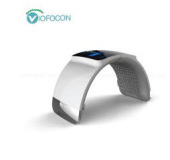LED Light Therapy Machine
SKU:
$625.00
$625.00
Unavailable
per item
LED Light Quantum Phototherapy Machine with Patent Design
LED offer a totally natural, non-ablative method for skin rejuvenation.The light from the LED interacts with cells and stimulates them to produce new collagen and elastin bio light therapy.Studies confirm that the same LED energy can be used to inhibit co-llagen formation. By manipulating the wavelengths, cells can be turned
on and off.
Yellow light are used for photo-rejuvenation.
Blue light are used in the treatment of acne.
Red light are used for photo dynamic therapy,
green Light reduce melanin cell,decreased pigment.
Red Light Function ~
Increased energy levels
Reduced local/systemic inflammation
Faster and better wound healing
Lower likelihood of scars
Reduces cortisol stress hormone levels
Activates formation of new cells for healing
Increased growth of new mitochondria
Improved blood flow / circulation
Increased lymph flow
Increased repair of skin including collagen
Function of calcium supplementation
Shang-Ru Tsai, Michael R. Hamblin,
Biological effects and medical applications of infrared radiation,
Journal of Photochemistry and Photobiology B: Biology,
Volume 170,
2017,
Pages 197-207,
ISSN 1011-1344,
https://doi.org/10.1016/j.jphotobiol.2017.04.014.
(http://www.sciencedirect.com/science/article/pii/S1011134416311691)
Abstract: Infrared (IR) radiation is electromagnetic radiation with wavelengths between 760nm and 100,000nm. Low-level light therapy (LLLT) or photobiomodulation (PBM) therapy generally employs light at red and near-infrared wavelengths (600–100nm) to modulate biological activity. Many factors, conditions, and parameters influence the therapeutic effects of IR, including fluence, irradiance, treatment timing and repetition, pulsing, and wavelength. Increasing evidence suggests that IR can carry out photostimulation and photobiomodulation effects particularly benefiting neural stimulation, wound healing, and cancer treatment. Nerve cells respond particularly well to IR, which has been proposed for a range of neurostimulation and neuromodulation applications, and recent progress in neural stimulation and regeneration are discussed in this review. The applications of IR therapy have moved on rapidly in recent years.
LED offer a totally natural, non-ablative method for skin rejuvenation.The light from the LED interacts with cells and stimulates them to produce new collagen and elastin bio light therapy.Studies confirm that the same LED energy can be used to inhibit co-llagen formation. By manipulating the wavelengths, cells can be turned
on and off.
Yellow light are used for photo-rejuvenation.
Blue light are used in the treatment of acne.
Red light are used for photo dynamic therapy,
green Light reduce melanin cell,decreased pigment.
Red Light Function ~
Increased energy levels
Reduced local/systemic inflammation
Faster and better wound healing
Lower likelihood of scars
Reduces cortisol stress hormone levels
Activates formation of new cells for healing
Increased growth of new mitochondria
Improved blood flow / circulation
Increased lymph flow
Increased repair of skin including collagen
Function of calcium supplementation
Shang-Ru Tsai, Michael R. Hamblin,
Biological effects and medical applications of infrared radiation,
Journal of Photochemistry and Photobiology B: Biology,
Volume 170,
2017,
Pages 197-207,
ISSN 1011-1344,
https://doi.org/10.1016/j.jphotobiol.2017.04.014.
(http://www.sciencedirect.com/science/article/pii/S1011134416311691)
Abstract: Infrared (IR) radiation is electromagnetic radiation with wavelengths between 760nm and 100,000nm. Low-level light therapy (LLLT) or photobiomodulation (PBM) therapy generally employs light at red and near-infrared wavelengths (600–100nm) to modulate biological activity. Many factors, conditions, and parameters influence the therapeutic effects of IR, including fluence, irradiance, treatment timing and repetition, pulsing, and wavelength. Increasing evidence suggests that IR can carry out photostimulation and photobiomodulation effects particularly benefiting neural stimulation, wound healing, and cancer treatment. Nerve cells respond particularly well to IR, which has been proposed for a range of neurostimulation and neuromodulation applications, and recent progress in neural stimulation and regeneration are discussed in this review. The applications of IR therapy have moved on rapidly in recent years.
Only 1 left!








